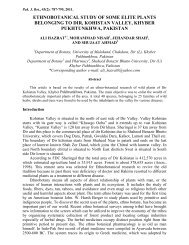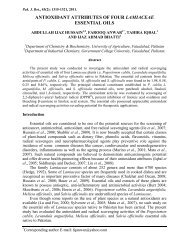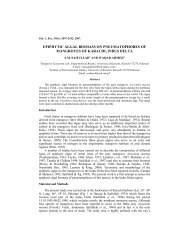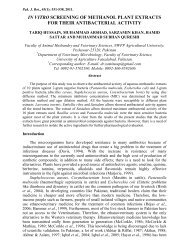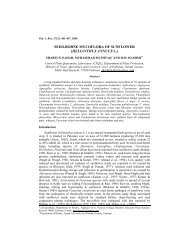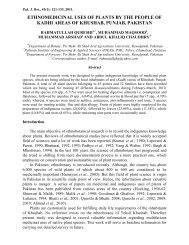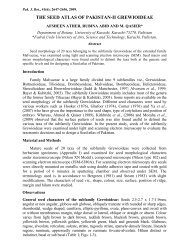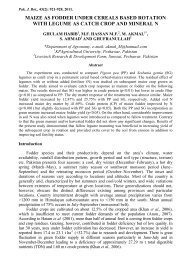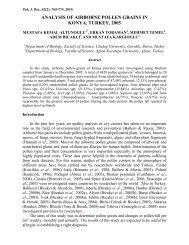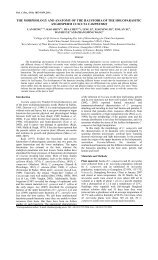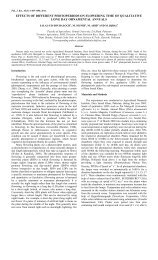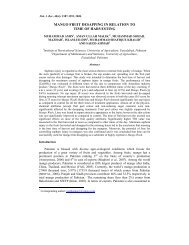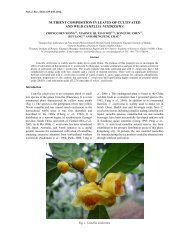POLLEN FLORA OF PAKISTAN -XLII. BRASSICACEAE ANJUM ...
POLLEN FLORA OF PAKISTAN -XLII. BRASSICACEAE ANJUM ...
POLLEN FLORA OF PAKISTAN -XLII. BRASSICACEAE ANJUM ...
You also want an ePaper? Increase the reach of your titles
YUMPU automatically turns print PDFs into web optimized ePapers that Google loves.
698<br />
<strong>ANJUM</strong> PERVEEN ET AL.,<br />
& Thoms.) Boiss., Diptychocarpus strictus (Fish.M.Beib.) Trautv, Diplotaxis harra<br />
(Forssk.) Boiss, Erysimum crassicaule (Boiss.) Boiss., Erysimum melicentae Dunn., E.<br />
repandum L., Farsetia ramosissima Hochst. ex Boiss., Malcolmia behboudiana Rech.f.,<br />
Moricandia sinaica (Boiss.) Boiss. Lepidium aucheri Boiss., Isatis costata C.A.Mey<br />
Key to the species and group<br />
1. + Pollen grains oblate-spheroidal………………………..……………..Isatis costata<br />
- Pollen grains prolate-spheroidal or prolate to sub-prolate ……………………… 2<br />
2. + Pollen grains prolate …………………………….. Erysimum crassicaule-subtype<br />
(Erysimum crassicaule,E. repandum, Barbaraea vulgaris)<br />
- Pollen grains sub-prolate …..…………..…………… Diplotaxis griffithii-subtype<br />
(Conringia planisiliqua, Crambe cardifolia, Descurainia sophia, Diplotaxis<br />
griffthii, Diptychocarpus strictus, Diplotaxis harra, Erysimum crassicaule,<br />
Erysimum melicentae, E. repandum, Farsetia ramosissima, Malcolmia<br />
behboudiana, Moricandia sinaica, Lepidium aucheri)<br />
Discussion and Conclusions<br />
Brassicaceae is a stenopalynous family (Erdtman, 1952). Pollen grains are generally<br />
prolate to sub-prolate or prolate – spheroidal rarely oblate – spheroidal, 3 - colpate often<br />
4-8 –colpate as in Erysimum stocksiana. Tectum reticulate, reticulum varies from fine –<br />
coarse. Appel & Al-Shehbaz (2003) also reported tricolpate reticulate pollen in the family<br />
Brassicaceae. However, they reported sparsely spinulose and punctate tectum in the<br />
genus Heliophila and 10-colpate pollen in few genera of Brassicaceae. Erdtman (1963)<br />
divided the species of Brassicaceae into two pollen types on the bases of exine thickness.<br />
Moore & Webb (1987) classified the family in tricolpate with reticulate pollen. Khalik<br />
(2002) divided the family into three pollen types on the basis of lumina size. The generic<br />
delimitation based on pollen morphology is difficult. However, on the basis of tectal<br />
surface four distinct pollen types are recognized viz., Arabis bijuga – type, Erysimum<br />
melicentae - type, Farsetia ramosissima - type, Draba lanceolate - type. The Arabis<br />
bijuga – type is easily recognized by having finely reticulate pollen, 20 species are<br />
included in this pollen type viz., Arabidopsis mollissima (C.A. Mey) Busch, A.<br />
traxacifolia (T.And.) Jafri, Arabidopsis wallichii (Hook. f. Thoms.) Busch, A. stricta<br />
(Camb.) Busch., Arabis amlpexicaule Edgew., A. bijuga Watt., Arabis pterosperma<br />
Edgew, Brassica juncea (L.) Czern., B. napus L., ssp., napus, B. nigra (L.) Koch., B.<br />
oleracea var. botrytis L., B. oleracea var. capitata, B. rapa ssp. rapa, B. rapa ssp.,<br />
campestris. Cardamine impatiens L., Chorispora. sibirica (L.) DC., Douepia tortuosa<br />
Camb., Drabopsis verna, Euclidium syriacum (L.) R.Br., Malcolmia. scorpioides<br />
(Bunge) Boiss. This pollen type is further divided into three subtypes on the basis of<br />
pollen shape classes (see key to the species or species group). Erysimum melicentae –<br />
type is delimited by its medium reticulate tectum, 12 species have medium reticulate<br />
tectum such as Alyssum desertorum Staph, Alliaria petiolata (M.Bieb.) Cav. Grande,<br />
Arabis saxicola Edgew, Arbidopsis pumila (Steph) Busch, Cardaria drapa, Cithareloma<br />
lehminniii, Coronocarpus didymus (L.) Smith, Diceratella canescens (Boiss.) Boiss.,<br />
Goldbachia laevigata (M.Bieb.) DC., Eremobium aegypticum (Spreng) Boiss., Erysimum<br />
melicentae Dunn., E. repandum L., E. griffithianum Boiss., Leptaleum filifolium (Willd.)



